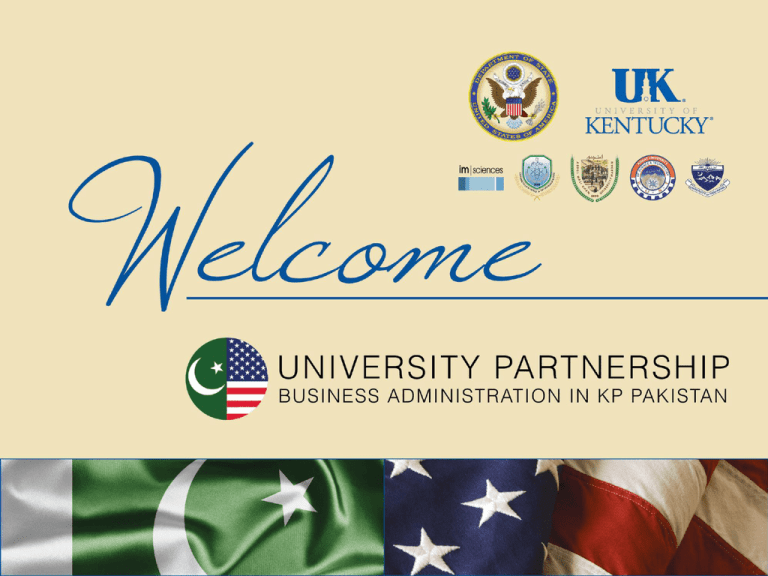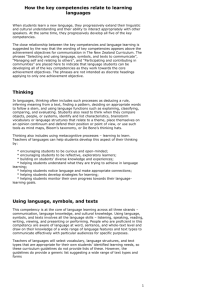Nancy Johnson Presentation
advertisement

Fine – Tuning the MBA Goals and Objectives University Partnership in Business Administration in KP Pakistan September 16, 2013 https://Gatton.uky.edu/Pakistan Learning Outcomes for this Session At the end of this session you will be able to: – Describe Tuning and Tuning Goals – Understand where we are in the Tuning Process & Next Steps http://www.tuningusa.org/TuningUSA/tuningusa.publicwebsite/b7/b70c4e0d-30d5-4d0d-ba75-e29c52c11815.pdf Historically education has been teacher centered. • • • • Teacher’s talking Lecture Textbooks Passive Students Source: http://iwansyahril.blogspot.com/2010/11/spring-2007-reflection-characteristics.html In recent years the focus has shifted to student centered education. • Student knowledge & skills. • Active learning. Student centered education considers what students should know and be able to do: • Upon Completing a Degree • Upon Completing a Class • Upon Completing an Class session • Upon Completing a Class Activity Tuning specifies and aligns what students should be able to know and do at the program level. Tuning was an invention of the EU’s Bologna Process. Every country defined a degree differently -to act as whole, they needed to align their curriculum. Tuning is now occurring throughout the world. The overarching goal of tuning is to develop program learning outcomes. Objective: to Win. But it is not to tell individual universities how to achieve these goals. Five Steps to Tuning Process Define Competencies & LO Map Employers Stakeholder Input Refine Competencies & LO Write degree profiles Step 1: Identify competencies • General statements about what students need to know and do • e.g.,: Oral and written competencies Learning outcomes are measurable. Competency: written communication • Learning Outcome: Every student completing an MBA will complete a well reasoned case analysis employing insights from accounting, marketing, management, and finance. Image source: http://www.tbs-sct.gc.ca/emf-cag/business-rentabilisation/bcg-gar/bcg-gar04-eng.asp STEP 2: MAP EMPLOYERS Where do students go following graduation? Step 3: Gather stakeholder Input • • • • • Faculty Students Employers Alumni Parents Focus groups Alltech Report Step 4: Refine Learning Outcomes based upon input. A STATEMENT OF WHAT STUDENTS KNOW AND DO UPON GRADUATION STEP 5: WRITE DEGREE PROFILE FOR EACH UNIVERSITY Tuning is an ongoing process that has several benefits. Purposeful Student centered Engages stakeholders Focuses on knowledge, skills, & abilities to make students successful employees • Provides basis for quality assurance & assessment • • • • Test: Can you? • Describe Tuning and Tuning Goals • Identify key phases in the Tuning process Competency Pakistan Kentucky • Students Should Be Able to Make Collective and Effective Decisions • Use critical thinking skills to identify creative and strategic solutions to complex business problems. • Communicate effectively and professionally in business settings using supporting documentation. • Analyze and respond to cultural dynamics in business and society. • Identify and formulate appropriate potential responses to ethical issues in business and society with an understanding of the consequences of personal, group, and organizational actions. • Communicate Effectively and Accurately in a Variety of Contexts. • Be able to think globally, act locally. • Students should understand and apply Team Skills both as a member and a leader of the team. Your Competencies Competency 1: Students Should Be Able to Make Collective and Effective Decisions Learning Outcomes • Explain various theories of decision making and group dynamics • Apply the appropriate theory and give logical reasons for making that theory the favored choice for the problem under consideration. • Propose a creative solution to the problem under consideration based on the decision making theory chosen Competency 2: Communicate Effectively and Accurately in a Variety of Contexts Learning Outcomes • Apply effective business communication processes to a variety of contexts. • Interpret the verbal and non-verbal behaviors of supervisors and subordinates. • Employ verbal and non-verbal communication effectively and accurately. • Use appropriate methods of communication inside and outside his or her organization. • Demonstrate methods of building rapport with various stakeholders. Competency 3: Be able to think globally, act locally Learning Outcomes • Identify global dynamics through using different analytical techniques. • Assess the effects of global dynamics on the local economy. • Modify business solutions based on the analysis of global dynamics and entrepreneurial ventures around the world. • Describe aspects of culturally sensitive behavior. Competency 4: Students should understand and apply Team Skills both as a member and a leader of the team. Learning Outcomes • Analyze the formal and informal group roles and statuses in order to impact group dynamics. • Appreciate the significance of inter-team communication. • Describe how self-awareness can improve one’s performance on teams. • Demonstrate leadership skills by evaluating the situation and proposing the appropriate leadership style to achieve team goals. • Describe how emotional intelligence improves group interaction. Charge For Next Day • Integrate Comments of Stakeholders to Revise Competencies • Consider – the validity of the comments – what comments were made several times – what comments were more offhand remarks – is this the job of the university For example: additional competencies suggested to IMSciences • know how to write business reports. • have knowledge to conduct market surveys. • have good planning and negotiation skills. • be comfortable with using software used for presentations and report writing such as MS Word, MS Excel, MS Power Point, Flash etc. In sum… Our goal for the next day is to refine the competencies. Prepare to begin the curriculum mapping and assessment process.







